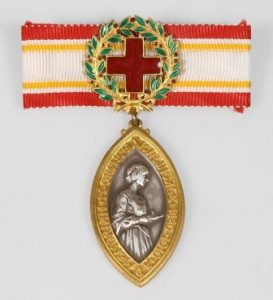Florence Nightingale Medal facts for kids
The Florence Nightingale Medal is a very special international award. It is given to nurses and nursing assistants who show amazing courage and dedication. The medal is named after Florence Nightingale, a famous British nurse. She is known for her important work in caring for sick and injured people.
The International Committee of the Red Cross (ICRC) created this medal in 1912. It is the highest honor a nurse can receive anywhere in the world. The medal is given to those who show great bravery and care for people who are hurt, sick, or disabled. It also honors those who help victims of conflicts or disasters. Sometimes, it is given for excellent work in public health or teaching nursing. A special group of nursing experts decides who receives this important award.
History of the Medal
The Florence Nightingale Medal was first planned to be given to six nurses each year. However, the First World War caused a delay. The very first 42 medals were finally awarded in 1920. These first recipients came from many different countries. They included nurses from Great Britain, Austria, Belgium, Czechoslovakia, Denmark, France, Greece, Hungary, Italy, Japan, Romania, and the United States.
Some of the early American nurses who received the award were Florence Merriam Johnson and Helen Scott Hay. For many years, only female nurses could receive the medal. But in 1991, the rules changed. Now, both women and men can be honored with this award. The medal is given out every two years. Up to fifty people from all over the world can receive it each time.
What the Medal Looks Like
The Florence Nightingale Medal has a unique shape, like two circles joined together. It is made of gold and silver. On one side, you can see a picture of Florence Nightingale. Around her picture are the words "Ad memoriam Florence Nightingale 1820–1910." This means "In memory of Florence Nightingale 1820–1910."
On the back of the medal, the name of the person who received it is carved. The date they received it is also there. Around the name, it says "Pro vera misericordia et cara humanitate perennis décor universalis." This means "true and loving humanitarianism – a lasting general propriety." The medal hangs from a white and red ribbon. It has a special clasp with a red cross surrounded by green leaves. Along with the medal, recipients also get a special paper certificate. Since 1927, they also receive a smaller version of the medal that is easier to wear. Usually, a country's leader presents the medal in a formal ceremony.
Recent Medal Awards
The Florence Nightingale Medal has been awarded many times over the years. Each time, a new "set" of medals is given out.
- In 2007, 35 people from 18 countries received the 41st set of medals.
- In 2009, 28 people from 15 countries received the 42nd set. This included the first nurse from Afghanistan to receive the award.
- In 2011, 39 people from 19 countries received the 43rd set. This included the first nurses from Kenya and the Central African Republic.
- In 2013, 32 people from 16 countries received the 44th set. One medal was given after the person had passed away.
- In 2015, 36 people from 18 countries received the 45th set. One medal was given after the person had passed away. This was for a nurse from Sierra Leone who worked in an Ebola treatment center.
- In 2017, 39 people from 22 countries received the 46th set. This included Sylvia Trent-Adams, a high-ranking nurse in the United States.
- In 2019, 29 nurses from 19 countries received the 48th set of medals.
- In 2021, 25 nurses from 18 countries received the 49th set. Two of these were given after the nurses had passed away.
- In 2023, 37 nurses from 22 countries received the 50th set. Three of these were given after the nurses had passed away. This included two ambulance drivers from Ethiopia and a nurse from Slovakia. A nurse from Tanzania also received the award for the first time.
- In 2025, 35 nurses from 17 countries received the 51st set of medals.
You can find a full list of all Florence Nightingale Medal recipients online. The ICRC Library has a special guide with this information.
See also
 In Spanish: Medalla Florence Nightingale para niños
In Spanish: Medalla Florence Nightingale para niños


